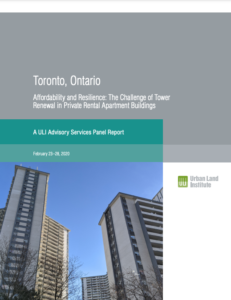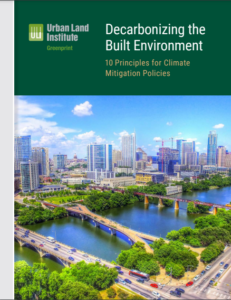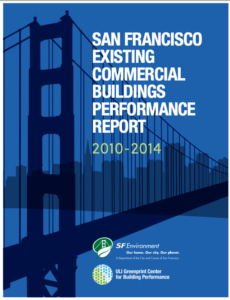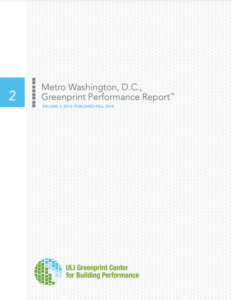City Reports
Climate Mitigation at the City Level
ULI Greenprint’s global community includes real estate owners and investors that have committed to voluntary energy benchmarking since 2009. By partnering with other voluntary and mandatory benchmarking initiatives and jointly producing benchmarking reports, ULI Greenprint collaborates to analyze data trends, share lessons learned and best practices, and provide recommendations for future efforts. These reports present energy consumption benchmarks and analyze year-over-year environmental performance for a subset of properties within a specific geographic area.
 | Toronto Advisory Services Panel Report Affordability and Resilience: The Challenge of Tower Renewal in Private Rental Apartment Buildings focuses on aging, purpose-built rental apartment buildings that are the backbone of Canada’s rental stock and are home to hundreds of thousands of households with modest and low incomes. Yet, these buildings are now over 35 years old and require substantial investment to continue to be safe, comfortable, and healthy places to live. While Toronto’s public and non-profit owned towers have made progress on deep retrofits, the goals of continued affordability and expanded investments in retrofits for housing quality and climate resilience do not align in private towers. The focus of the panel was to determine how the public and private sectors can work together to unlock the necessary investments and drive sustainable retrofits of Toronto’s towers while maintaining affordability. |
 | Downtown DC BID Advisory Services Panel Report D.C. Vision 2050: An Effective Strategy and Plan for Real Estate Owners to Achieve D.C.’s Sustainability Goals summarizes an advisory services panel that made recommendations to the DowntownDC Business Improvement District (BID) on the real estate industry’s role in achieving the city’s sustainability goals, and on how the goals can be leveraged to generate real estate value and boost economic growth in the city’s downtown. The panelists provided strategic recommendations on how the DowntownDC BID and building owners can cost-effectively meet DC’s sustainability goals, and how the District can help facilitate compliance to achieve them. |
 | Decarbonizing the Built Environment With leading cities refining their climate action plans and hundreds of more cities preparing to develop plans, the public and private sectors can unite around a set of principles to help accelerate progress toward these shared climate action goals. This recent report from ULI Greenprint, prepared in partnership with USDN, serves as a starting point for cities interested in engaging real estate leaders during the shaping of climate mitigation policies, and for real estate organizations to increase their understanding of the potential impact of these policies—providing useful tools to help city officials and those in the real estate industry engage with each other in a meaningful and ongoing way. |
 | San Francisco, California The San Francisco Existing Commercial Buildings Performance Report 2010-2014 is the result of a collaboration between Greenprint and the San Francisco Department of the Environment. The report found that energy consumption by commercial properties in San Francisco has declined significantly since 2011 after the implementation of San Francisco’s Existing Commercial Buildings Energy Performance Ordinance. |
 | Volume 1: 2012 DC Performance Report DowntownDC established the DowntownDC area as an ecoDistrict in 2011 to provide a framework in which to educate and promote sustainable practices such as the better management of energy, water and waste and multi-modal transportation investments. The DowntownDC ecoDistrict’s goals include reducing peak and overall energy consumption, enhancing economic performance, and increasing market share of downtown buildings. The DowntownDC ecoDistrict supports developing and promoting DowntownDC as one of the most sustainable downtowns in the world.Together the ULI Greenprint Center and DowntownDC developed two Building Performance Reports, one on office buildings, and the second on multifamily and office properties. These reports created by both organizations offers a glimpse of the analysis that is possible for the metro Washington, D.C., real estate market and is the starting point to examine trends and opportunities specific to properties in metro Washington. |
 | Volume 2: 2013 DC Performance Report DowntownDC established the DowntownDC area as an ecoDistrict in 2011 to provide a framework in which to educate and promote sustainable practices such as the better management of energy, water and waste and multi-modal transportation investments. The DowntownDC ecoDistrict’s goals include reducing peak and overall energy consumption, enhancing economic performance, and increasing market share of downtown buildings. The DowntownDC ecoDistrict supports developing and promoting DowntownDC as one of the most sustainable downtowns in the world. Together the ULI Greenprint Center and DowntownDC developed two Building Performance Reports, one on office buildings, and the second on multifamily and office properties. These reports created by both organizations offers a glimpse of the analysis that is possible for the metro Washington, D.C., real estate market and is the starting point to examine trends and opportunities specific to properties in metro Washington. |